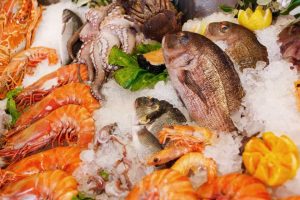Seafood affordability influences consumption of more nutritious species


Adults with low incomes eat substantially less seafood high in Omega 3s—a fatty acid with confirmed health benefits—compared to those with high incomes, according to a new study led by researchers at the Johns Hopkins Center for a Livable Future. The study also found wide differences in seafood consumption by race and ethnicity. The Center is based at the Johns Hopkins Bloomberg School of Public Health.
Nearly 90% of Americans do not eat seafood twice a week, as recommended in the U.S. Dietary Guidelines. Seafood, the most expensive protein, is outside of many people’s budgets. Understanding consumption patterns by income, race, and ethnicity, as well as seafood species, price, and source, could help efforts to promote greater and smarter seafood consumption.
The researchers found a strong association between income and seafood price; people with low incomes ate 18% less seafood every week than those with high incomes. The study also found that seafood high in long-chain n-3 polyunsaturated fatty acids—commonly known as Omega 3s—accounted for 18% of all seafood in the diets of people with low incomes, 28% for those with middle incomes, and 33% for those with high incomes. Seafood high in Omega 3s, such as salmon, also costs more at retail than species low in Omega 3s.
Across race and ethnicity groups, low- and middle-income Asians were the only groups on average to eat the recommended amounts of seafood; among higher income Asians, consumption dropped off. Seafood consumption by other races and ethnicities sharply increased for upper-income groups, however. Among these groups, only the diets of non-Hispanic Blacks with higher incomes approach the recommended amounts.
The study was published online June 13 in the American Journal of Clinical Nutrition.
“Although seafood is nutritious, the higher cost of seafood poses a barrier to Americans with lower incomes,” says David Love, Ph.D., lead author of the study and senior scientist with the Center for a Livable Future. “Eating seafood twice a week can be challenging on a tight budget, but it can be done—for example, buying seafood that is frozen or canned instead of fresh.”
Nearly 3,000 species are categorized as seafood. Lower-priced species with favorable nutrient profiles—those with Omega 3s, vitamins, and minerals—include mackerel, herring, mussels, octopus, and eel. Of these five species, only mussels are eaten with any degree of frequency, comprising 2% of the seafood consumed by adults with low incomes and 1% by adults with high incomes. The researchers note that many Americans consume only a limited range of species that includes mostly shrimp, salmon, canned tuna, tilapia, and cod.
To conduct the analysis, the researchers examined dietary data from the National Health and Nutrition Examination Study (NHANES). The dataset covered years 2011 through 2018 and included information on 17,559 individuals, 3,285 of whom had consumed seafood. The dataset categorized four groups of adults: Hispanic, non-Hispanic white, non-Hispanic Black, and non-Hispanic Asian. NHANES data was also used to analyze seafood intake by species, including species high in Omega-3 fatty acids.
Additionally, the researchers used data from NielsenIQ to assess retail prices (using an average from 2017-19 prices) by seafood type, and data from the Food and Nutrient Database for Dietary Studies to assess nutrient values for seafood in relation to price. The researchers used trade data to determine seafood production methods and habitat.
The researchers found that Americans consume a mix of farmed and wild-caught seafood, and the majority comes from the ocean. Farmed fish can provide different levels of nutrients than wild caught fish because their feed includes soybean meal and oil and other crops, instead of or in addition to the species’ natural diets. The authors note that choices about what parts of a fish to eat and how seafood is prepared—fried versus baked— also have important health implications.
Source: Read Full Article